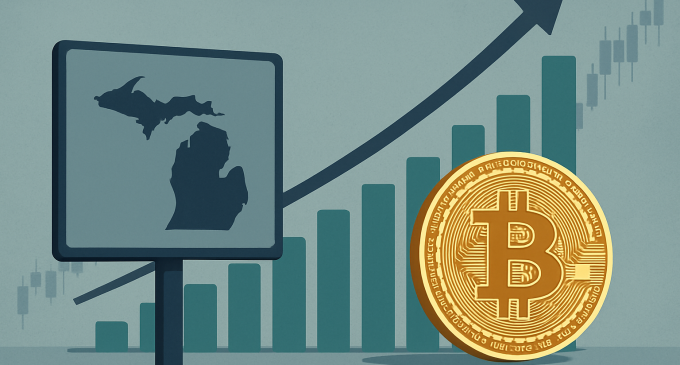
Introduction
In a move that continues to redefine the role of digital assets in institutional portfolios, the Michigan State Pension Fund has tripled its holdings in a Bitcoin Exchange Traded Fund (ETF), raising its total investment to a staggering $10.7 million. This strategic decision, which emerged in early August 2025, has sent ripples through both the crypto industry and traditional finance sectors, offering yet another layer of validation for Bitcoin as a legitimate and increasingly sought-after asset class.
The development represents more than just a portfolio adjustment. It’s a turning point that highlights the growing convergence between public finance and decentralized digital assets. It underscores the rising institutional confidence in cryptocurrencies, particularly Bitcoin, which continues to be viewed as a hedge against inflation and a long-term store of value.
Institutional Confidence And A Historic Shift In Asset Strategy
For years, traditional financial institutions and pension funds have approached cryptocurrencies with caution. The volatility, lack of regulation, and unfamiliar mechanics of blockchain technology left many decision-makers wary. However, the tide began to turn in 2023 and 2024, with regulatory frameworks becoming clearer, custodial services maturing, and crypto ETFs gaining wider approval. Now, in 2025, we are witnessing the next evolution—direct, proactive investment by state-run pension funds into digital assets.
The Michigan State Pension Fund’s decision to increase its Bitcoin ETF exposure is a hallmark of this shift. Public pension funds are generally considered conservative, with their portfolios designed to generate long-term returns for thousands of retirees. These funds traditionally hold a mix of government bonds, blue-chip equities, and real estate assets. For such a fund to make a significant bet on Bitcoin—through a regulated ETF structure—signals both confidence in the asset class and a readiness to adapt to changing financial paradigms.
Bitcoin ETFs: Bridging The Gap Between Traditional Finance And Crypto
Exchange Traded Funds, or ETFs, have long been favored by institutional investors for their liquidity, ease of access, and transparent management. The introduction of Bitcoin ETFs in 2023 opened the floodgates for capital inflows into the crypto markets from investors who had previously been sidelined due to custody issues or risk mandates.
ETFs such as BlackRock’s iShares Bitcoin Trust (IBIT) and Fidelity’s Wise Origin Bitcoin Fund offered a regulated and accessible vehicle for gaining exposure to the world’s most prominent cryptocurrency without dealing with the operational complexities of wallets and private keys. The Michigan State Pension Fund’s latest investment is believed to be in one or more of these established ETFs, although the specific fund was not disclosed in the report published by Bitcoin Magazine.
This move was made in a climate of increasing interest from other large entities as well. In the past year alone, major hedge funds, insurance companies, and now public pensions have diversified their holdings to include Bitcoin ETFs. The justification is no longer merely speculative. Many now view Bitcoin as digital gold—a finite, decentralized asset that can protect portfolios from fiat currency devaluation.
Why Now? Timing The Market And Strategic Diversification
The decision to triple its holdings in August 2025 appears both calculated and timely. Bitcoin has been relatively stable over the past few months, hovering between 57,000 and 63,000 USD per BTC, with signs of sustained support levels. This relative calm in price movement has created a window of opportunity for long-term investors to accumulate before the next potential rally.
The Michigan pension board likely evaluated this investment through the lens of risk-adjusted return. While Bitcoin remains more volatile than traditional assets, it also presents outsized upside potential. With the ETF wrapper mitigating some of the operational risks and offering regulatory compliance, the investment becomes more palatable for institutions with fiduciary responsibilities.
Additionally, with inflationary pressures continuing to loom over global markets, especially in the wake of fiscal expansion and supply chain restructuring, Bitcoin’s hard-capped supply of 21 million coins presents a compelling hedge. Unlike fiat currencies, which can be printed endlessly, Bitcoin is deflationary by design. That feature alone has prompted many to consider it a modern hedge against economic instability.
Pension Fund Managers And Their Long-Term Outlook
For fund managers responsible for the financial future of thousands of retirees, every decision carries significant weight. While critics may argue that cryptocurrencies are still too risky for pension portfolios, proponents suggest otherwise, pointing to the evolving nature of modern portfolios in an increasingly digital economy.
It’s important to note that Michigan’s $10.7 million investment in Bitcoin ETFs, while substantial, still represents a small fraction of the total fund size, which is estimated to be over $80 billion. This suggests a cautious yet optimistic strategy—one that allows for exposure to emerging technologies while maintaining a conservative risk profile.
The incremental approach also offers flexibility. If the Bitcoin ETF performs well, additional capital may be allocated in future quarters. Conversely, if the asset underperforms or market conditions change, fund managers can reduce exposure without incurring the complexities of liquidating direct crypto holdings.
Broader Implications For The Crypto Market
The implications of this move go far beyond Michigan. As the first domino in what could become a cascade of public pension investments, this action may serve as a catalyst for other states and municipalities to follow suit. Already, rumors are swirling about similar considerations in states like Texas, Florida, and California, each of which has sizable pension obligations and an appetite for diversified assets.
The endorsement of Bitcoin ETFs by public institutions helps to normalize crypto investing, reducing stigma and fostering regulatory acceptance. It also improves market liquidity and stability, as institutional investors tend to adopt long-term positions that reduce volatility caused by speculative trading.
From a market psychology standpoint, the involvement of pension funds can also serve to reassure retail investors. Confidence begets confidence. When the public sees institutional gatekeepers putting their trust—and money—into Bitcoin, it signals a maturation of the market that many have long awaited.
Crypto Regulation And Risk Mitigation
This increase in institutional participation also places additional pressure on regulatory bodies to keep up with innovation. While the Securities and Exchange Commission (SEC) has already approved multiple Bitcoin ETFs, questions around custody, tax reporting, and cross-border transactions remain.
The Michigan State Pension Fund’s move may therefore also serve as a case study in how traditional institutions can engage with crypto assets within a compliant and transparent framework. It also pushes ETF providers to maintain the highest standards of security, disclosure, and reporting.
Moreover, such investment moves could help pave the way for similar ETF approvals in Ethereum, Solana, or other digital assets, further expanding the crypto market’s appeal to institutional players.
Financial Literacy And Public Perception
As pension funds invest in digital assets, public awareness and education will become increasingly important. The average retiree or taxpayer might not understand how Bitcoin functions, much less why it is being added to their pension fund. Communication from pension boards, therefore, becomes critical in ensuring transparency and managing expectations.
This also opens doors for broader financial literacy campaigns about blockchain technology, decentralized finance, and the evolution of monetary systems. Bitcoin is no longer just a niche investment for tech-savvy millennials. It is entering the portfolios of teachers, firefighters, and government employees—people whose livelihoods depend on the prudent management of pension capital.
Looking Forward: A New Financial Frontier
The Michigan State Pension Fund’s decision to triple its Bitcoin ETF holdings marks a new chapter in institutional finance. It is not merely an endorsement of Bitcoin as an asset class, but a reflection of a broader trend toward digital transformation in finance. As ETFs continue to serve as the bridge between traditional markets and blockchain-based assets, the future of institutional crypto investment looks increasingly robust.
Bitcoin, often described as an asset of the future, is now being embraced by some of the most risk-averse and heavily scrutinized financial managers in the world. That speaks volumes about where we are headed.
The question is no longer whether institutions will adopt crypto—it is how quickly they will do so, and how much capital they are willing to commit. With moves like Michigan’s leading the way, the answer may come sooner than expected.
Conclusion
The Michigan State Pension Fund’s decision to triple its Bitcoin ETF holdings to $10.7 million is not just a noteworthy financial maneuver—it’s a powerful endorsement of Bitcoin’s growing role in institutional finance. This strategic investment highlights how far the crypto industry has come in just a few short years, evolving from a speculative asset class to one increasingly integrated into the portfolios of mainstream financial institutions.
By stepping into Bitcoin via a regulated ETF structure, Michigan’s pension fund has managed to balance innovation with responsibility. It is signaling that cryptocurrency—particularly Bitcoin—is no longer a fringe asset but a credible component of long-term financial planning, even in the traditionally risk-averse world of public pensions.







There are no comments at the moment, do you want to add one?
Write a comment